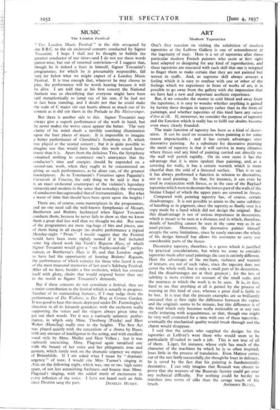ART
Modern Tapestries
ONE'S first reaction on visiting the exhibition of modern tapestries at the Lefevre Gallery is one of astonishment at
the ingenuity of man. Here is a set of tapestries after those particular modern French painters • who seem at first sight least adapted to designing for any kind of reproduction, and these tapestries are executed with such skill that one is tempted to finger them to make certain that they are not painted but woven in stuffs. And, as supreme skill always arouses a feeling which it is easy to confuse with one or other of the feelings which we experience in front of works of art, it is possible to go away from the gallery with the impression that we have had a new and important aesthetic experience.
But, if we consider the matter in cold blood and away from the tapestries, it is easy to wonder whether anything is gained
by having these designs in tapestry rather than in the form of paintings, and whether tapestries of this kind have any raison d'être at till. If, moreover, we consider the purpose of tapestry and the function which it really has to fulfil our doubts become even more clearly founded.
The main function of tapestry has been as a kind of decor•. ation. It can be used on occasions when painting is for some reason impracticable ; and it has certain advantages over decorative painting. As a substitute for decorative painting the merit of tapestry is that it will survive in many climates where fresco and any kind of painting carried out directly on the wall will perish rapidly. On its own score it has the advantage that it is more opulent than painting, and, as a covering for walls, it has a certain warmth which is more cheerful than the cold of a frescoed surface. That is to say it has always performed a function in relation to decorative, not to easel painting. So that, for instance, it can even be used in conjunction with fresco, as in the case of the Raphael tapestries which were to decorate the lowest part of the walls of the Sistine Chapel of which the upper parts are covered in fresco.
Compared with painting tapestry has, of course, certain disadvantages. It is not possible to attain to the same subtlety of handling as in pigment, since the tapestry as finally seen is a copy made by a hand which did not design the original. But this disadvantage is not of serious importance in decoration, which is meant to be seen at a distance, and in which, therefore, details of handling cannot be seen in the same way as in an easel-picture. Moreover, the decorative painter himself accepts the same limitations, since he rarely executes the whole of his design himself but allows his assistants to carry out considerable parts of the fresco.
Decorative tapestry, therefore, is a genre which is justified by practical considerations, but when we come to consider tapestries made after easel paintings the case is entirely different. Here the advantages of the me iium, richness and warmth of texture, are not of such value, since the tapestry does not cover the whole wall, but is only a small part of its decoration. And the disadvantages are at their greatest ; for the loss of subtlety is more evident on account of the small scale, and the nearness at which the work is to be seen. It is, in fact, hard to see that anything at all is gained by the process of weaving in this kind of case, whereas a great deal is liable to be lost. It is true that the present examples are so brilliantly executed that at first sight the difference between the copies and the originals seems to be minute, but this difference is of the kind which only beconies really noticeable or at any rate really irritating with acquaintance, so that, though one might be very well contented for a time with one of these tapestries, eventually the mechanical quality would break through and the charm would disappear.
I said that the artists who supplied the designs for the tapestries at Lefevre's were those who would seem to be particularly ill-suited to such a job. This is not true of all of them. Leger, for instance, whose style has much of the character of the machines by which he is so often inspired, loses little in the process of translation. Even Matisse comes out of the test fairly successfully, for though he loses in delicacy, he is saved by the fact that his painting is fundamentally decorative. I can only imagine that Rouault was chosen to prove that the weavers of the Beauvais factory courd get over any technical difficulty. For nothing could be harder to translate into terms of silks than the savage touch of his










































 Previous page
Previous page